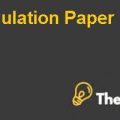Investment Policy At New England Healthcare Case Study Analysis
The Eastside cash balance pension plan accounted for paying a retirement amount with the help of an accumulating account balance. The wage account was credited each year by 5% of total wage along with an interest rate, which accumulated each year and paid at last. The loss or gain on any investment would be accounted for the employer and does not impact the account balance of employee. The total of $600 million was in westside pension plan along with an accumulated benefit obligation of $500 million and a projected benefit obligation was approximately $550 million.
ercent from the lowest return yielding stock (Jay O. Ligth, Akiko M. Mitsui and Luis M. Viceira, 2003). (See appendix 1 and 3 for asset allocation calculations).
The current target allocation of both pension funds pool should be allocated on the basis of its respective stock’s returns and the historical average return, because it could be seen that in the previous allocation, the more weightages had been given in the stocks which are yielding low returns. Thus, new asset allocation had been formulated, which proposed that 50.6% should be allocated to the equity stock, 18.1% should be allocated to the fixed income and the remaining 31.3% should be allocated to the alternative investment options. Furthermore,the westside pension fund should incorporate 45% of the totalinvestment, while Eastside pension fund should incorporate 55% of the investment in the investment pool.
Recommendations
After evaluating all the possible options with the help of qualitative and quantitative analysis, it is recommended thatthe company should allocate more on those assets, which is yielding an increased return as compared to other assets.The investment was comprises on two pension fund and the long term investment portfolio. Furthermore, it could be seen that the total expected portfolio return had been calculated by multiplying both investments’ return and weightages, which is yielding a 6.5% return. Moreover, the entire calculationsreflected that the long-term portfolio consisting on 5% of investment along with 42% of pension fund investment. Both pension plan would be allocated on same assumptions because of same expected return formulation.
Conclusion
It is concluded that the New England Healthcare established, when two research hospital and urban teaching merged, in 1994. The investment committee set forth the mutual funds investment policies. It was expected that health-care facilities will bear an additional operating pressure because of rising unemployment, government cost-controlled efforts and an increasing labor cost. The committee was considering about the future asset allocation. The weightages of associated investment portfolio include the 58% of long-term investment pool with the inclusion of 42% of pension fund. The total expected portfolio return had been calculated as 6.5%..............................
This is just a sample partical work. Please place the order on the website to get your own originally done case solution.










